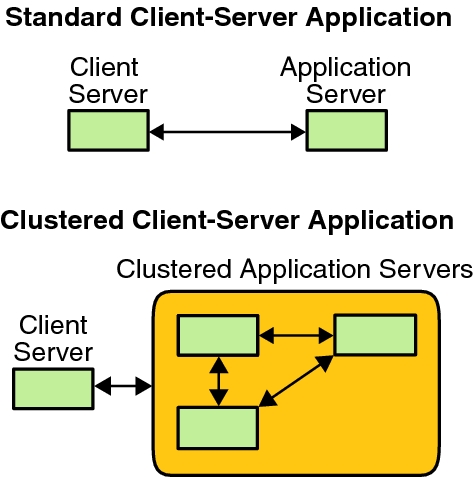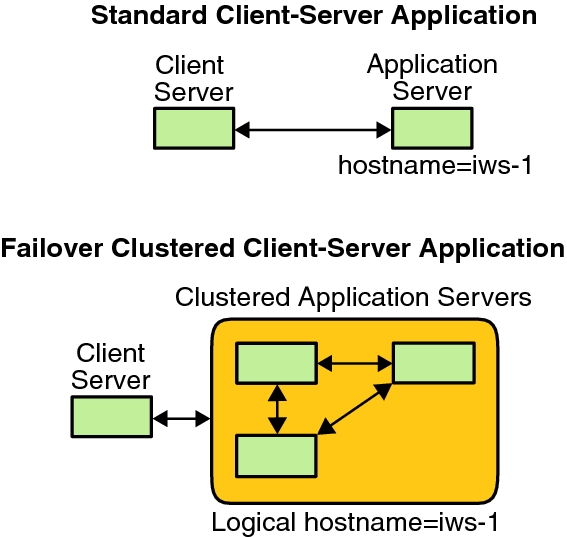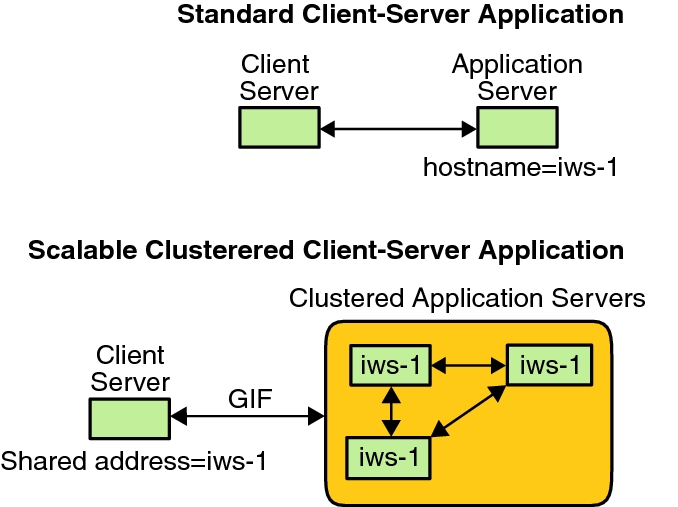Data Services
The term data service describes an application, such as Oracle iPlanet Web Server, that has been configured to run on a cluster rather than on a single server. Data services enable applications to become highly available and scalable services help prevent significant application interruption after any single failure within the cluster. A data service consists of an application, specialized Oracle Solaris Cluster configuration files, and Oracle Solaris Cluster management methods that control the following actions of the application:
Start
Stop
Monitor and take corrective measures
There are two types of data services: single-mastered (or failover) and multi-mastered (or parallel). Some multi-mastered data services, referred to as scalable services, are designed to take advantage of Oracle Solaris Cluster network load balancing when configured with a SharedAddress resource.
Figure 3–3 compares an application that runs on a single application server (the single-server model) to the same application running on a cluster (the clustered-server model). The only difference between the two configurations is that the clustered application might run faster and is more highly available.
Figure 3-3 Standard Compared to Clustered Client-Server Configuration

In the single-server model, you configure the application to access the server through a particular public network interface (a host name). The host name is associated with that physical server.
In the clustered-server model, the public network interface is a logical host name or a shared address. The term network resources is used to refer to both logical host names and shared addresses.
Some data services require you to specify either logical host names or shared addresses as the network interfaces. Logical host names and shared addresses are not always interchangeable. Other data services allow you to specify either logical host names or shared addresses. Refer to the installation and configuration for each data service for details about the type of interface you must specify.
A network resource is not associated with a specific physical server. A network resource can migrate between physical servers.
A network resource is initially associated with one node, the primary. If the primary fails, the network resource and the application resource fail over to a different cluster node (a secondary). When the network resource fails over, after a short delay, the application resource continues to run on the secondary.
Figure 3–4 compares the single-server model with the clustered-server model. Note that in the clustered-server model, a network resource (logical host name, in this example) can move between two or more of the cluster nodes. The application is configured to use this logical host name in place of a host name that is associated with a particular server.
Figure 3-4 Fixed Host Name Compared to Logical Host Name

A shared address is also initially associated with one node. This node is called the global interface node. A shared address (known as the global interface) is used as the single network interface to the cluster.
The difference between the logical host name model and the scalable service model is that in the latter, each node also has the shared address actively configured on its loopback interface. This configuration enables multiple instances of a data service to be active on several nodes simultaneously. The term “scalable service” means that you can add more CPU power to the application by adding additional cluster nodes and the performance scales.
If the global interface node fails, the shared address can be started on another node that is also running an instance of the application (thereby making this other node the new global interface node). Or, the shared address can fail over to another cluster node that was not previously running the application.
Figure 3–5 compares the single-server configuration with the clustered scalable service configuration. Note that in the scalable service configuration, the shared address is present on all nodes. The application is configured to use this shared address in place of a host name that is associated with a particular server. This scheme is similar to how a logical host name is used for a failover data service.
Figure 3-5 Fixed Host Name Compared to Shared Address
